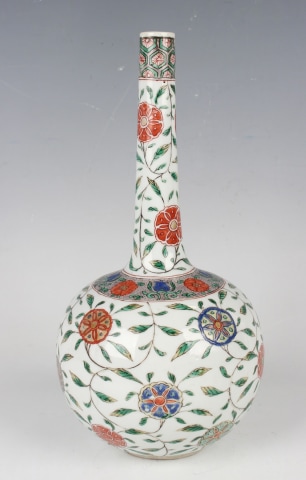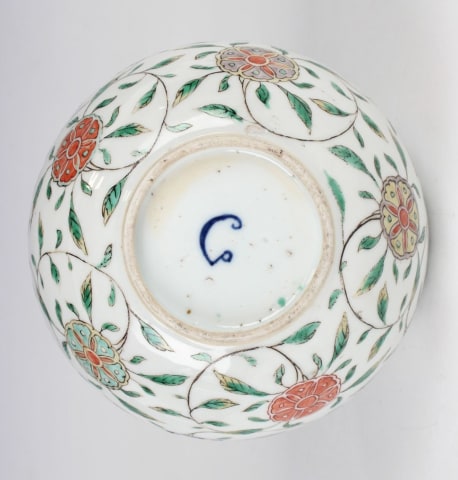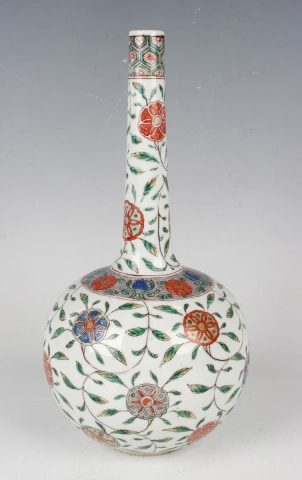A Chinese Famille Verte Bottle Vase, Kangxi (1662-1722)
Height: 25cms
BH46
BH46
Further images
Of globular form rising to a tall cylindrical neck, enamelled with stylised floral medallions borne on leafy scrolls, the shoulder with alternating flower heads on an aubergine ground, the neck...
Of globular form rising to a tall cylindrical neck, enamelled with stylised floral medallions borne on leafy scrolls, the shoulder with alternating flower heads on an aubergine ground, the neck with further stylized floral meander and surmounted by a diaper cell band , the base with an underglaze blue 'G' mark.
Literature
The shape of the bottle is based on a Western glass model and would have contained spirits. The 'G' mark on the base is an enigma.It occurs on both famille verte enamelled porcelain and blue and white. It is always from the Kangxi period (1662-1722) and mostly of high quality suggesting that this type of "G"-marked ware was of superior grade, custom made perhaps for a discriminating member of the East India Company, a private merchant, or for some elevated individual in England or the Netherlands to distinguish the wares made exclusively for him but to date the use of the Roman letter "G" inscribed in underglaze blue on the base still remains an enigma.
For another almost identical example see Christiaan J.A. Jorg in collaboration with Jan van Campen, Chinese Ceramics in the Collection of the Rijksmuseum, Amsterdam, published by Phillip Wilson and the Rijksmuseum Amsterdam, 1997 pl. 299, p. 260. These bottles are also inscribed on the base with the letter "G". A famille-verte vase of this pattern and with the same mark is illustrated in John Ayers, Chinese Ceramics, The Koger Collection, London, 1989, pl. 11 and in Michel Beurdeley and Guy Raindre, Qing Porcelain, London, 1987, col. pl. 47.
There is a famille verte teapot in the Groninger Museum in the Netherlands which also bears this unusual "G"-mark on its' base illustrated in Christiaan J.A. Jorg, Famille Verte Chinese Porcelain in Green Enamels, Groninger Museum, 2011, p. 132, pl. 120.
For a pair of blue and white examples see our website here
See our website for another object with Roman letters on the base here . This flask was probably ordered for the General Governor of the V.O.C., Pieter Van Hoorn.
One day we will know who the enigmatic 'G' was who ordered fine examples of Kangxi porcelain.






